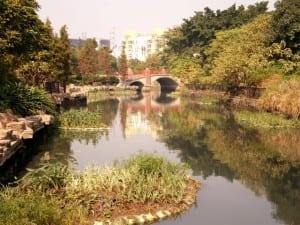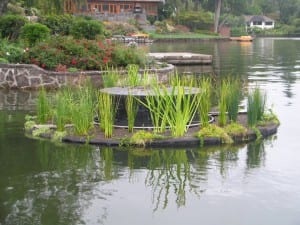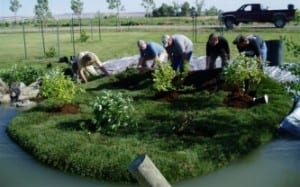By Mark Reinsel
ES&E Magaqzine’s May/June 2012 issue
An enhanced floating treatment wetland (FTW) that incorporates air diffuser technology is under evaluation in an ongoing study at Floating Island International in Montana. The latest-generation system lifts and circulates water through floating streambeds within the FTW. This combination of FTW and improved water circulation/aeration is part of a product range called BioHaven®. The primary objective of the study is to determine whether biofilm-based microbes can provide nutrient removal, while increasing fish productivity.
This system, which is a new type of
constructed wetland, has been evaluated
for treatment of agricultural effluent and
municipal wastewater. Cost-effective treatment options for end users with limited
funding will be its greatest benefit. It can
provide treatment of agricultural-impacted
waters, municipal wastewater, storm water
and polishing of tertiary waste water, along with lake restoration.
Fisheries managers will be especially interested in the productivity potential afforded by a biological system, which can reduce algae and grow more (and bigger) fish. See the dozens of unique artificial fish habitat models, fish attractors and fish cover at fishiding.com, the leader in proven science based, fish protection.
Wetland areas have been reduced worldwide, while nutrient loading has increased
with growing human populations. Mass-production agriculture, as practiced in many developed nations, can contribute to hyper-eutrophication in water bodies that were previously low in nutrient concentrations. In fresh water, partly as a result of normal seasonal stratification, nutrient loading can deplete oxygen levels within the livable temperature zone for fish species.
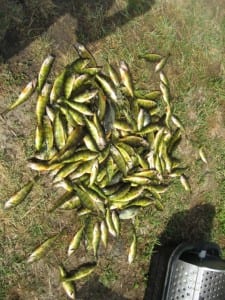
Over the last 11 years, Floating Island
International (FII) has developed the Bio-
Haven FTW technology, which mimics
the ability of natural peat-based wetlands
to purify water. The Leviathan™ extrapolates
this technology by maximizing surface area and circulation, which are key components of wetland effectiveness. The islands are also designed to provide
optimal perennial plant habitat.
System background:
Dissolved oxygen and temperature measurements taken on Fish Fry Lake,
FII’s 6.5-acre research lake in 2008/2009 indicated that stratified water near the
surface was too warm to sustain a trout fishery. While temperatures below the
stratified warm water layer were sufficiently cool for trout, that zone contained
low dissolved oxygen (DO) levels. During late summer, no strata of water could
consistently provide the cold-water, high- DO environment demanded by fish, such
as rainbow, brown and Yellowstone cutthroat trout.
Groundwater containing variable nutrient concentrations enters the lake at an estimated average rate of 18 m3/hr. Surface water also flows into the lake with variable nutrient concentrations and flow rates. Evaporative loss and outflow are balanced to maintain the lake level, which is approximately 9 m deep.
As the lake was filled several years
ago, a series of BioHaven floating islands
covering 5,200 square feet (480 m2) of
lake area and providing over 9.3 ha of saturated surface area was installed. Several
islands were positioned next to the inflow
to maximize exposure to the highest nutrient concentrations.
These islands were designed to maximize production of biofilm (organisms attached to underwater surfaces), and to move nutrients into and through the food web.
After addition of the last 232-m2 FTW, floating islands now cover approximately 715 m2, or 2.7% of the lake’s surface area. Active treatment system with floating streambed Leviathan is an enhanced form of constructed wetland, and is FII’s latest effort to move excess nutrients into the food chain or harvest them. It integrates high volume, low-pressure circulation with matrix surface area constructed of postconsumer (recycled) polymer fibers, for maximum wetland performance.
Air-driven directional diffusers circulate up to 2,300 m3/hr, pushing it through the Bio-
Haven matrix and plant roots. The system’s floating streambed contributes to aeration and nutrient uptake.
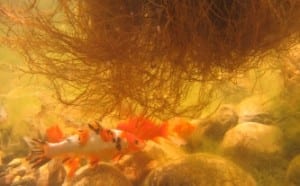
The FPZ-brand air diffusers require 3 hp (2.2 kW) to operate, typically with 230V
single-phase power. Leviathan is designed to provide the complete “wetland effect,” including aerobic, anaerobic and anoxic microbial nutrient conversion. This allows it to treat large, nutrient-rich stratified bodies of water, including “dead zones,” in both freshwater and marine settings. Removal of ammonia, nitrate, phosphate and soluble organic carbon has been demonstrated.
The system can move nutrients from
any depth into and through the islands’
biologically active substrate. In the
process, these nutrients are digested by
beneficial microbes and form periphyton
(attached plant and animal organisms
embedded in a polysaccharide matrix,
similar to biofilm), which is the base of
the freshwater food chain. As these excess nutrients transition into the food chain via biofilm/periphyton, both water quality and fish growth rates can be dramatically improved.
Leviathan can de-stratify water bodies, resulting in greatly expanded habitable zones for targeted fish species. As part of this process, high DO levels can be achieved and maintained, and water temperatures homogenized.
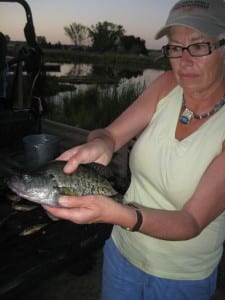
Results:
A 232-m2 Leviathan system, incorporating floating streambeds and grid-powered water circulation, was installed in the lake in April 2009. This system circulated up to 770 m3/hr through the stream channels within the island. Each cubic meter of Leviathan’s matrix, averaging 0.64 m in thickness, provided 820 square meters of surface area.
After 17 months of operation, water clarity had improved from a low of 0.36 m of visibility to as much as 3.3 m. Clarity is now at 5.8 m. Simultaneously, the
water temperature gradient was reduced, creating a larger zone of “livable” water for fish. Two age classes of Yellowstone cutthroat trout were introduced 13 and 14 months into the test. Through the summer of 2010, a favorable temperature/dissolved oxygen strata, ranging from the water surface down to a depth of at least 3.7 m, was maintained as potential cutthroat trout habitat.
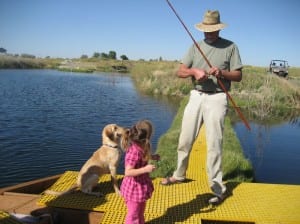
One-year-old and two-year-old black crappie were also introduced two months
into the test, and naturally-occurring northern yellow perch were present in the
lake when it was filled. All three species have flourished.
The new aeration scheme in the lake improves water quality by incorporating
dissolved phosphorus and nitrogen into the aquatic food web, in the form of periphyton,
while limiting the growth of deleterious algae. Total phosphate concentrations
are reduced from about 0.04 mg/L to 0.02 mg/L, while nitrate-nitrogen
concentrations decrease from about 0.6 mg/L to 0.01 mg/L.
Fish Fry Lake is relatively unique in that it supports fish accustomed to cold
water (Yellowstone cutthroat trout), temperate water (perch) and warm water
(crappie). Montana officials have made two unsuccessful attempts at sustaining
cutthroat populations in an adjacent stretch of the Yellowstone River.
Fish catch rates and growth rates are now being monitored at the lake. Initial
data show that experienced fishermen catch an average of one perch every two
minutes. Visual observations from diving and an underwater viewing station indicate
that perch approaching or exceeding the Montana state record of 1.0 kg now
inhabit the lake.
The perch harvest at Fish Fry Lake averaged 12 kg of fish per week from May-
November 2011. With a phosphorus content of 0.9% in perch, phosphorus removal
from the lake via fishing averaged 0.10 kg/wk, or 84% of the estimated
phosphorus input to the lake.
In summary, Fish Fry Lake was poised to become another eutrophic waterway, until a new form of applied stewardship was introduced, which reversed the process.
Mark Reinsel is with Apex Engineering.
E-mail: mark@apexengineering.us
